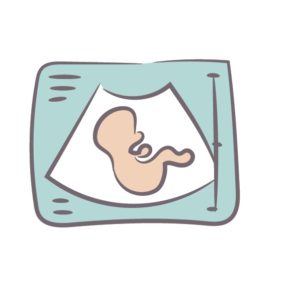Gravid uge for uge: Hvad sker der inde i maven igennem de 40 ugers graviditet? Her kan du følge din graviditet uge for uge. Helt fra baby er en lille spire, til han eller hun er fuldbåren og klar til at møde verden.
Indholdsfortegnelse
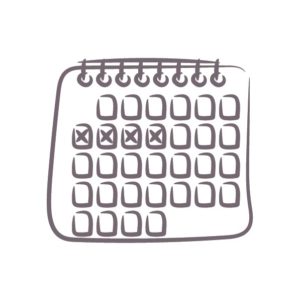 Ægløsning
Ægløsning
I denne uge sker ægløsningen. Det sker ved at ægget løsner sig fra æggestokken, og begiver sig ned mod livmoderen. Ægget kan blive befrugtet i 12 – 24 timer efter ægløsningen. Sædceller kan overleve op til en uge, så hvis man har haft sex i dagene op til ægløsningen, eller på dagen, er der chancer for at opnå graviditet.
Tegn på ægløsning
- Humørsvingninger
- Stikkende smerter i siden
- Øget udflåd
Beregn ægløsning
Er du i tvivl om hvornår din ægløsning finder sted, kan du beregne den ved brug af appen Clue. Her kan du indtaste hvornår du sidst har haft menstruation, samt længden på din cyklus. Så vil appen lave en god oversigt over din cyklus samt frugtbare periode.
Du kan også købe billige ægløsningsteste her.
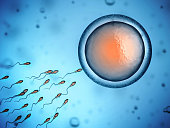
Ægget befrugtes og kønnet bestemmes
Ægget befrugtes, og sætter sig fast i livmoderen. Sædcellen afgør barnets køn, så snart den trænger ind i ægget. Så det er faktisk allerede nu bestemt, om det bliver en dreng eller pige.
Sådan sker befrugtningen
Sædcellerne er med i et kapløb mod ægget. Sædcellerne er udstyret med en hale, og svømmer op i æggelederen. Kun én sædcelle når frem til ægget, og trænger ind i det. Herefter begynder ægget at dele sig, og bevæger sig ned mod livmoderen. Her når det frem inden for en uge, og sætter sig fast i livmodervæggen. Der er en graviditet i gang!
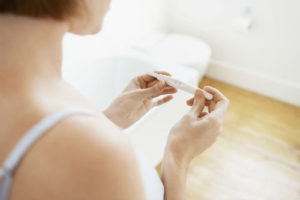
Positiv graviditetstest
I denne uge kan de fleste teste positivt på en graviditetstest. Hver dag stiger graviditetshormonet HCG i kroppen. Mange kvinder kan allerede nu mærke de er mere trætte end normalt.
Du kan købe billige graviditetsteste her. Det er også muligt at blive testet gratis hos lægen. Hvis du vælger at teste hjemme vil det bedste resultat opnås ved, at teste med morgenurin da indholdet af HCG er langt højere om morgenen.
Udebleven menstruation
For de fleste kvinder er den udeblevne menstruation det første tegn på at de er gravide. De teste man køber i dag, er så gode, at de kan fange en graviditet allerede fra første dag menstruationen er udeblevet.
Anbefalede kosttilskud til gravide
Sundhedsstyrelsen anbefaler at gravide tager disse kosttilskud:
- 400 mg folinsyre fra graviditeten planlægges og til og med uge 12
- 40 – 50 mg. jern fra 10. graviditetsuge og resten af graviditeten
- 10 mg D vitamin gennem hele graviditeten
- ½ liter mælkeprodukter om dagen eller 500 mg gennem hele graviditeten
Kvalme og træthed – kroppen arbejder på højtryk
Barnet måler nu 4 mm. og hjertetslaget kan opfanges via ultralyd. Centralnervesystemet der indebærer hjerne og rygmarv er sammen med muskler og knogler ligeledes ved at tage form. Rygraden er allerede dannet og nervebundter mellem ryghvirvlerne forgrener sig nu gennem hele kroppen. Du begynder måske at få kvalme og har lyst til madvarer, du normalt ikke spiser.
Råd mod kvalme
- Spis mange små måltider i løbet af dagen, i stedet for få store
- Spis kiks eller knækbrød
- Spise syrlige bolcher
- Børste tænder
- Bananer
- Mandler
- Tag B6 vitamin (snak med din læge eller jordemoder først)
- Ingefærte (tag dog ikke kosttilskud med ingefær)
- Er kvalmen slem om morgenen, så spis lidt inden du står op
- Prøv akkupunktur
- Indret din dag, så du kan hvile dig på de tidspunkter kvalmen er værst
- Accepter, at det er en midlertidig periode
Baby vejer 1 gram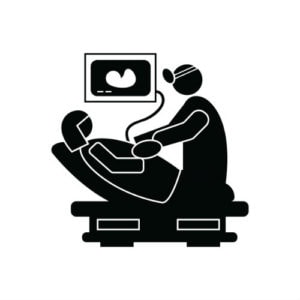
Baby vejer nu omkring 1 gram og i løbet af denne uge vil barnet tredoble sin størrelse. Det er nu muligt at se begyndelsen til øjne, ørernes kontur, munden og nogle gange allerede næsen. I de første uger af graviditeten er fosteret meget følsomt overfor alkohol. Måske er maven allerede begyndt at bule lidt. Især om aftenen kan man blive meget oppustet.
Tryghedsscanning
Hvis du føler dig meget usikker, og er bekymret, så er det muligt at få lavet en tryghedsscanning i denne tidlige del af graviditeten. Det bliver gjort privat hos scanningsklinikker. Her er det muligt at se hjertet blinke, hvilket er en bekræftelse på, at graviditeten indtil videre forløber som den skal.
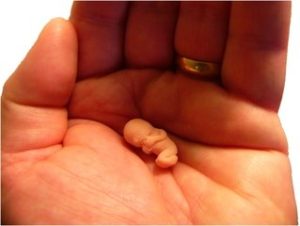 Baby vokser 1 mm om dagen!
Baby vokser 1 mm om dagen!
Nu er baby på størrelse med en aflang ært og vokser omkring 1 mm. om dagen. Barnets hjerne udvikler sig med hastige skridt og der opstår hele tiden nye forbindelser mellem nervecellerne. Barnet kan bevæge sig og øjnene udvikles. Nogle kvinder er i denne del af graviditeten meget plaget af kvalme og træthed, mens andre endnu ikke mærker meget til forandringen. Lyt til din krop, og gå evt. tidligere i seng end normalt.
Tid til 1. lægebesøg: Det kan du forvente
Tidspunktet kan variere lidt, men det er ved at være tid til at få lavet vandrejournal hos lægen. Fremover skal vandrejournalen medbringes til alle lægebesøg og jordemoderbesøg. Du skal også have taget en blodprøve, som skal bruges til samlet at lave en risikovurdering til nakkefoldsscanningen.
- Snak om du ønsker nakkefoldsscanning og misdannelsesscanning, der tilbydes af staten
- Lave vandrejournal og fastsætte termin
- Har du ønsker mht. valg af jordemoder
- Snak om din cyklus og eventuelle tidligere graviditeter
- Om graviditeten er spontan eller opnået med behandling
- Hvor du ønsker at føde
- Snak om kroniske sygdomme eller misdannelser i familien
De første ansigtstræk viser sig
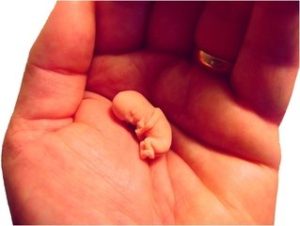 Din baby ligner et rigtigt lillebitte menneske, da ansigtstræk begynder at vise sig. Barnets sanseorganer og de primære indre organers grunlæggende funktioner er udviklet. Da livmoderen vokser dag for dag, kan de såkaldte ligamentsmerter begynder at tage til. De kan føles som nivende smerter omkring underlivet.
Din baby ligner et rigtigt lillebitte menneske, da ansigtstræk begynder at vise sig. Barnets sanseorganer og de primære indre organers grunlæggende funktioner er udviklet. Da livmoderen vokser dag for dag, kan de såkaldte ligamentsmerter begynder at tage til. De kan føles som nivende smerter omkring underlivet.
Det er helt naturligt hvis du oplever mindre smerte i underlivet, der kan beskrives som menstruationssmerter. Hvis smerterne derimod tager til og bliver ledsaget af blødninger, så skal du kontakte din læge eller jordemoder.
Baby er så stor som et jordbær
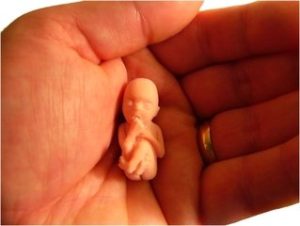 Baby er nu på størrelse med et jordbær. Selve nervesystemet og hjernecellerne udvikles og modnes løbende. Barnets kønsorganer begynder nu at blive dannet. Der sker store forandringer i din krop, og det er helt normalt at have svingende humør og føle det hele er meget overvældende.
Baby er nu på størrelse med et jordbær. Selve nervesystemet og hjernecellerne udvikles og modnes løbende. Barnets kønsorganer begynder nu at blive dannet. Der sker store forandringer i din krop, og det er helt normalt at have svingende humør og føle det hele er meget overvældende.
Derfor skal du huske jerntilskud
I denne periode begynder store mængder af blod at tilføre næring til moderkagen. Det betyder at mængden af blod i din krop vil stige hvilket kan resultere i, at din blodprocent vil falde. Du kan derfor godt føle dig lidt svimmel og utilpas, hvorfor det er vigtigt at spise mad der indeholder jern.
Tissetrang
Du træder ind i en periode hvor du kan føle en konstant tissetrang Det er normalt at skulle tisse ofte, da livmoderen vokser og trykker på blæren. Sørg for at tisse når du skal og få tømt blæren hver gang.
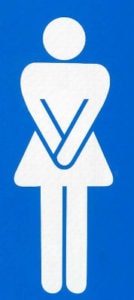
Som gravid kan du opleve øget tissetrang, hvilket ikke altid er lige belejligt.
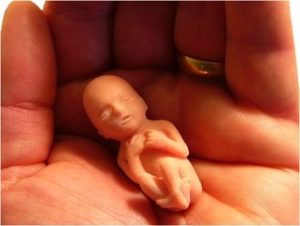 Mindre lyst til sex og luft i maven
Mindre lyst til sex og luft i maven
Baby vejer nu 15 gram og er 35 mm. fra hoved til hale. Alle barnets indre organer er nu dannet og bliver lige så stille modnet hen over de næste 30 uger. Hjertet, hjernen og nervesystemets funktioner er fuldt udviklet.
Da den gravides mave er begyndt at arbejde langsommere, kan nogle gravide døje med forstoppelse og/eller luft i maven i større eller mindre grad. Husk at drikke godt med vand. På grund af kroppens forandringer kan det ligeledes for nogle betyde mindre lyst til sex og humørsvingninger.
40 – 50 g ferrojern
Sundhedsstyrrelsen anbefaler at gravide fra den 10. graviditetsuge tager jerntilskud på 40 – 50 gram dagligt, og resten af graviditeten. Blodmængden i kroppen øges, og derfor har man brug for jern. Ved jernmangel kan man opleve træthed og komplikationer ved blodtab under fødslen. Man kan i dag få mange forskellige slags jerntilskud. Nogle jerntilskud er mere hårde for maven end andre. Hvis du er i tvivl så kontakt din læge eller spørg apoteket til råds.
Du kan se mere om kosttilskud her.
Når denne uge er gået, vil fosterets hoved og krop være lige lange. Fosteret kan nu åbne og lukke munden, og øjnene kan skelne lys fra mørke (ikke fordi der er meget lys i livmoderen). Barnet er nu på størrelse med en tørret abrikos! Selvom du snart er ovre den sårbare periode og første trimester, så vil mange måske stadig ikke ane at du er gravid. Sørg for at bevæge dig lidt hvis du ikke dyrker motion i forvejen. Det vil være godt for din fordøjelse og kroppens forandring. Husk at drikke rigeligt med vand, da der både skal produceres øget blod til livmoderen og fostervæske.
At offentliggøre graviditeten
Mange offentliggøre deres graviditet omkring dette tidspunkt. Det kan føles som en lettelse endelig at fortælle det til sine omgivelser, og det er en stor glæde at dele nyheden.
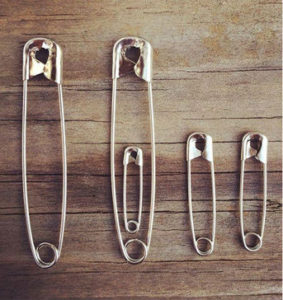
Offentliggør I skal have en lille ny ved at ligge sikkerhedsnåle op på denne måde. En super sød og enkel måde at vise det på.
Fosterets hjerne går igennem vigtige forandringer. Anlæggene til tænder er på vej og barnet kan nu synke. Fosteret svømmer rundt i livmoderen, men du kan endnu ikke mærke bevægelser. Barnet måler lidt over en halv centimeter, men har allerede udviklet en stor del af kroppen.
Det 1. trimester varer til og med uge 12. Alle vitale organer er dannet. Det første og mest sårbare trimester slutter næste uge.
Nakkefoldsscanning
Omkring uge 13 skal de fleste til nakkefoldsscanning. Her måler man fosterets næseben og tykkelsen på nakkefolden. Scanningen og den blodprøve som du tidligere har fået taget, giver herefter en samlet risikovurdering af eventuelle kromosonfejl. Her kan der blandt andet være tale om risiko for Down Syndrom og cystisk fibrose. Du får svar på risikoberegningen lige efter scanningen.
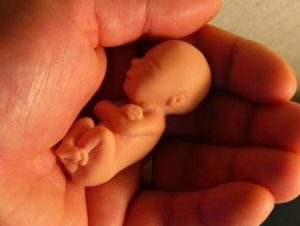 Tillykke! Du er nu i 2. trimester
Tillykke! Du er nu i 2. trimester
Abort risikoen er nu meget lav. Alle barnets organer skal nu færdigudvikles og fungere sammen. Barnet begynder allerede nu at øve sig i at trække vejret, ved at bevæge sit bryst. Fosteret måler omkring 7 cm.
2. trimester kaldes af mange for “Den Gyldne Periode”, da kvalmen så småt aftager for de fleste gravide og man generelt får det bedre med mere overskud.
Folinsyre er ikke længere nødvendigt
De første tre måneder af graviditeten er nu overstået, og du behøver ikke længere tage folinsyre dagligt. (sundhedsstyrelsens anbefaling).

Barnet er på størrelse med en blomme
Barnet kan nu både holde og dreje hovedet. Hænderne kan gribe og fødderne kan sparke. Det er dog stadig for tidligt at mærke liv. Da fostervæsken som barnet ligger i øges dag for dag, kan det snart betyde, at der skal lidt løsere tøj til at føle dig godt tilpas. Det kan være at du allerede nu skal investere i graviditetsbukser og lidt løsere bluser.
Indkøb af babyudstyr
Nu hvor I er ovre den mest sårbare periode i graviditeten, er det på tide at begynde at overveje hvilket babyudstyr I kunne tænke jer.
Guide til de bedste barnevogne her
Guide til bedste vugge og tremmeseng her
Barnet er så stor som en appelsin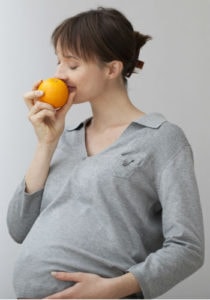
Øjnene fortsætter med at bevæge sig på rette plads og øjenbrynene kan nu ses. Ved udgangen af denne uge kan barnet knytte hånden. Lillehjernen og rygmarven er dannet. Hos nogle gravide kan man begynde at spotte maven, hvor det hos andre slet ikke kan ses.
Det siges at andengangs gravide har en tendens til at blive lidt større, hvorfor maven måske allerede er tydelig. I og med at livmoderen vokser opad og udad, vil tissetrangen hos de fleste aftage. Nogle gravide kan risikere at få hjertebanken, hvilket er helt naturligt. Det er simpelthen fordi at din krop skal kunne mestre den øgede blodmængde som samtidig med barnets iltbehov, har øget dit hjerte med en kapacitet på 20%.
Kønsscanning
Fra 14 fulde uger, er det som regel muligt at fastlægge barnets køn. Mange kommende forældre er nysgerrige efter at vide barnets køn, hvorimod andre enten venter til misdannelsesscanning (Det er en gratis scanning fra det offentlige omkring uge 20) eller helt venter til barnet er født. Til de forældre som ikke kan vente med at få stillet deres nysgerrighed, kan man hos flere private scanningsklinikker bestille tid til en kønsscanning. Priserne varierer en del og flere klinikker tilbyder ligeledes pakkeløsninger, så det også er muligt at få en 3D scanning senere i graviditeten.

Der er fortsat god plads for barnet til spark og bevægelser
Barnet kan nu rynke på øjenbrynene, sutte på tommelfinger og sluge fostervand. Barnets hår vokser og det såkaldte lanugohår begynder at dække hele kroppen. Man siger at formålet med lanugohår er, at det skal være med til at holde på det hudfedt som dannes den næste måned. Lanugohårene vil først forsvinde i slutningen af graviditeten. Der går ikke længe før du vil kunne mærke de første tegn på liv. De fleste gravide vil kunne mærke bevægelser et sted mellem uge 16 og uge 20. Nogle børn er dog mere aktive end andre.
Find forskellige liggepositioner
Når man som gravid bliver større og større kan det på et tidspunkt blive ubehageligt at ligge på ryggen. Det har noget at gøre med, at barnet i denne position kan trykke mod din store hovedpulsåre og således afskære blodstømmen gennem kroppen. Du kan derfor have følelsen af at besvime. Der er ikke noget farligt i at ligge på ryggen, men hvis du oplever ubehag så skift endelig position. Nogle gravide kan også have gavn af at have en pude mellem benene hvis de ligger på siden, da puden kan støtte kroppens position når der slappes af.
Barnet er omtrent samme størrelse som en avocado.
Barnets krop er tynd og huden er stadig gennemsigtig. Øjnene er nu dækket af øjenlåg, men de åbner sig først omkring uge 27. Barnet kan nu reagere på lyde og er opmærksom på sine omgivelser. Det betyder også at barnet kan blive forskrækket ved høje lyde. Fra denne uge vejer barnet nu mere end moderkagen.
1. Jordemoderbesøg
Det første jordemoderbesøg er ofte omkring uge 17. Den første samtale foregår med generel information. Der bliver som regel også snakket om kost og andre omstændigheder omkring din graviditet. Nogle jordemødre tjekker allerede ved første konsultation barnets hjertelyd.
Udviklingen fortsætter, men væksten sker knap så hurtigt nu
Barnet vokser og vejer nu ca. 150 gram. Øjnene er rykket tættere mod forsiden af ansigtet og der er nu også antydning til øjenvipper. Ørerne har fået deres rette placering. Barnet kan høre mors hjerte slå og det kan nu drikke af fostervandet som kan give hikke.
Ekstra jerntilskud
Da blodmængden i kroppen øges under en graviditet, kan du have brug for ekstra jern. Det anbefales allerede fra uge 10 at tage jerntilskud under graviditeten. Du kan også supplere med madvarer, der er rige på jern som eksempelvis broccoli og spinat.
Barnets hørelse er nu fuldendt
Mellem uge 15 og uge 20 udvikles barnets hørelse. Det betyder at barnet nu kan høre dine hjerteslag, når tarmene bobler, når du nyser, hoster, bøvser og griner. På et tidspunkt vil barnet endda blive bevidst om din stemme.
Livmoderen er blevet stor, og det kan give flere og mere smertefulde ligamentsmerter. Undgå at presse din krop, men sørg alligevel for at motionere og røre dig i det omfang det er muligt. Kvinder der dyrker motion under fødslen har oftere kortere og nemmere fødsler. Der er mange gravide som får de såkaldte pigmentpletter i ansigtet og på kroppen. De vil normalt forsvinde efter fødslen. Husk dog en god solcreme hvis du opholder dig meget i solen, da pigmentpletter kan blive permanente.
Råd mod hævede og ømme ben
Den tunge livmoder trykker på blodkarrene, og kan gøre det sværere for blodet at løbe tilbage fra benene. Løsningen er at ligge sig med benene oppe. Gerne på gulvet med benene oppe på en stol.
Tillykke – du er nu halvvejs!
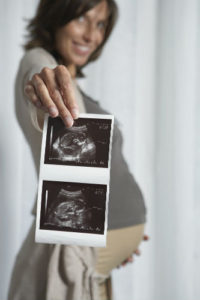
Der er nu kun 20 uger tilbage til terminen. Det er en spændende tid du går i møde. Selvom det er hårdt at være gravid, så mind dig selv om at nyde tiden.
I uge 20 vurderes barnet til at veje omkring 400 gram, og 25 cm. langt. På dette tidspunkt har de fleste gravide taget 3-5 kg. på. Alle børn følger normalt samme udviklingsmønster indtil uge 20. Men fra denne uge bliver barnets vækst mere individuel set i forhold til forældrenes højde og vægt. Barnet kan nu sutte på tommelfinger og øver sig i sutteteknikken.
Nogle gravide kan i denne periode godt have tilbagevendende træthed. Det har blandt andet at gøre med den øget væskemængde i dit blod. Hvis du føler dig træt, så fortsæt endelig med dit jerntilskud.
Misdannelsesscanning (MD scanning)
I uge 20 bliver du tilbudt en misdannelsesscanning. Det er en grundig scanning hvor alle barnets organer scannes, heriblandt hjerte, hjerne og kropsdele. Her kan det fastlægges om barnet har klumpfod, hjertefejl, læbe/ganespalte eller andre misdannelser. Kønnet kan også fastlægges, men det kommer lidt an på hvor samarbejdsvillig barnet er til scanningen.
Barnet kan nu optage næring
I uge 21 har tarmene udviklet sig, således at barnet optager næring fra fostervæsken. Det er fortsat moderkagen der forsyner barnet med mad, men nu kan det passerer igennem tarmene og ned til tyktarmen. Barnet er nu meget aktiv, og du vil kunne mærke liv hver dag.
Fra denne uge begynder maven virkelig at vokse, og huden strækker sig. Mange gravide har stor glæde af at smøre huden med oliebaseret hudplejeprodukter som eksempelvis mandelolie. Døjer du meget med halsbrand kan det hjælpe at drikke mælk eller en håndfuld mandler (tyg dem grundigt).
Jordemoderbesøg
Det er igen tid til jordemoderbesøg. Her vil barnets vægt skønnes, og det bliver tjekket om barnet vokser som det skal. Til alle jordemoderbesøg bliver urin og blodtryk ligeledes tjekket. Det er både for at holde øje med en eventuel blærebetændelse, da gravide ikke nødvendig får smerter heraf samt om blodtrykket er stabilt.
Barnet kan nu beskrives som en nyfødt i miniatureudgave
Barnet er nu så stor, at bevægelser kan mærkes udenpå maven. Babys hud er stadig meget tynd og lidt rødlig. Nerveenderne er udviklet, hvilket betyder at de nu kan formidle selve fornemmelsen for berøring.
Maven er ved at være stor og det kan især give gener i form af halsbrand og bækkensmerter. Du kan i denne periode godt føle dig mere varm end normalt. Det er fordi at skjoldbrugskirtlen er mere aktiv under en graviditet.
Graviditetssvømning
Hvis du har mulighed for det, kan det være en god ide at gå til graviditetssvømning. Mange svømmehaller har hold særligt til gravide. Vandet kan være med til at støtte maven, så den ikke føles så tung og presset fra vandet i svømmehallen kan også mindske eventuelle gener i forhold til vand i kroppen.
Barnet øver fortsat åndedrætsbevægelser
Barnet vejer nu cirka 540 gram og kroppen er nu ved at danne pigment. I denne uge tager lungerne et kvantespring, idet alveolerne dannes. Man mener at barnet på dette tidspunkt kan drømme. Gad vide hvad babyen drømmer om?
Som regel er barnet rolig når du går eller er i bevægelse, da man her kan beskrive det som at barnet bliver vugget i søvn. Når du ligger stille og slapper af, er det tilgengæld ikke unormalt at baby synes det er tid til gymnastik.
Humørsvingninger og træning af bækkenbunden
Det er helt normalt fortsat at opleve humørsvingninger, da det er en del af at være gravid. Nogle gravide føler det mere end andre. Det er kroppens måde at forberede dig på det du har i vente.
Da livmoderen nu befinder sig over din blære, kan den nemt komme til at trykke på den ved bestemte bevægelser. Det kan resultere i små uheld hvis du for eksempel hoster, nyser eller løfter noget tungt. Husk dig selv på at lave knibeøvelser allerede nu, så du kan træne dit bækken. På den måde kan du også slippe for de små uheld.
Barnet kan kende forskel på op og ned
Barnet er nu så udviklet, at han/hun kan kende forskel på stemmer. Barnet vil derfor kunne genkende moderens stemme ved fødslen. I denne uge er barnets indre øre udviklet. Det er med til at styre barnets balance og derfor kan barnet nu fornemme forskellen på op og ned.
Lyt til din krop
Da livmoderen bevæger sig længere og længere op mod din navle, skubber den automatisk dine organer op og væk. Det kan for nogle gravide resultere i svimmelhed, halsbrand og generel træthed. Husk også at forkæle dine fødder når nu der bliver mere og mere at bære rundt på. Du bør i hvert fald finde nogle gode og behagelige sko.
Barnet har nu udviklet sine fingeraftryk
Barnet vejer omkring 800 gram, og har både udviklet små fingernegle og fingeraftryk. Barnet øver sig i at udforske sine kropsdele, da hænderne er fuldt funktionsdygtige. Udvikling af lungerne er i fuld gang, og barnet øver sig fortsat i at trække vejret.
Flere gravide kan i denne periode godt blive ramt af sammentrækninger i for eksempel læggen, der også kaldes krampe. Hvis det skulle ske, så kan du massere forsigtigt på det udvalgte område eller stille dig op og strække dit ben med selve foden bøjet op ad væggen.
Lægebesøg
I denne uge er det tid til 2. lægebesøg. Her får du tjekkes dit blodtryk, får taget en urinprøve og måske bliver du vejet. Lægen spørger også ind til hvordan det går, og du kan få svar på eventuelle spørgsmål.
Barnets hjerne forandrer sig
Baby har nu en kampvægt på 850 gram, og sparkene bliver stadig kraftigere. Du kan nu mærke, at barnet fylder en del i livmoderen. Barnets hjerne gør nu plads til alle de små nerveceller, hvorfor den begynder at danne de karakteristiske fordybninger. Barnet reagerer så meget på lys nu, at den vil kunne holde hænderne op foran øjnene når lyset rammer den.
Barnet mærker dine følelser
Baby kan smage når moderen spiser noget meget sødt eller surt. Barnet reagerer ligeledes på dine stresshormoner som kroppen producere. Det betyder at dine følelser også påvirker barnet hvis du for eksempel er træt, stresset eller ked af det. Barnet reagerer også på de positive ting, da alle dine endorfiner strømmer via blodet og igennem navlestrengen.

Barnet træner nu øjenmusklerne
Barnet kan nu åbne øjnene og træner dem ved at åbne og lukke og kigge til hver side. Det siges også at barnet fra denne uge har store chancer for, at overleve hvis en fødsel allerede skulle finde sted. Barnets systemer er endnu ikke færdigudviklet, men den har hvad der skal til for netop at overleve.
De fleste gravide er nu meget besværet, og du nærmer dig sidste del af graviditeten. Du har måske taget en del på, men de fleste af kiloene er stadig ekstra blod og vand i kroppen. Det er fortsat vigtigt at du prioriterer at slappe af, så du ikke bliver stresset. Mange begynder for alvor at gå i gang med at indrette børneværelset og tilkøbe babyudstyr.
Læs guide til barnevogne her.
Barnet får nu opbygget mere kropsfedt
Dette er sidste uge af 2. trimester. Baby vejer nu omkring 1 kg., og er meget livlig. Lungerne modnes mere og mere. I den kommende sidste del af graviditeten skal barnet mest af alt bare tage på. Du vil derfor opleve at maven vokser virkelig meget i de sidste uger. Barnet har indtil videre tidoblet sin vægt på 11 uger og øger fra denne uge sin vægt med 27 gram hver dag.
Kontakten med dit barn
I denne periode kan du føle at du mister pusten hurtigere end normalt. Det er simpelthen fordi at barnet vokser og derved gør mindre plads til din mave og lunger. Kontakten til dit barn er blevet mere virkelig. Har du lagt mærke til at barnet nu selv kan skubbe lidt tilbage hvis du prikker til maven?
Tillykke – du er nu i 3. trimester af din graviditet!
Du går nu ind i slutspurten af din graviditet. Fra nu af vokser baby hurtigt, og tager på hver eneste uge. Baby vejer nu cirka 1200 gram. Mange oplever mere vand i benene, og er nød til at ligge sig med benene oppe for at lindre smerterne. Halsbranden tager også til, hvis du har døjet med det indtil nu. Det skyldes at livmoderen presser mavesækken opad. Du kan også risikere at blive ramt af forstoppelse, da dine tarme ikke fungerer så effektivt på grund af hormoner. Maven vokser, huden strækker sig, og de fleste føler sig efterhånden besværet af graviditeten. Sørg fortsat for at slappe af, men samtidig bevæge dig i det omfang du kan.
Jordemoderbesøg
Det andet eller tredje jordemoderbesøg ligger omkring uge 29. Her tjekker jordemoderen som altid din urin og dit blodtryk. Hun mærker på maven, og undersøger om baby ligger med hovedet nedad. Fra nu af bliver jordemoderbesøgene hyppigere.
Tillykke – der er nu kun 10 uger til du skal se din baby!
Barnet vejer nu cirka 1400 gram og lungerne er næsten fuldt udviklet. Barnet øver sig fortsat i at trække vejret og kan risikere at få hikke. Det vil du specielt kunne mærke som små sammentrækninger i livmoderen og det vil kunne ske tit i løbet af de næste uger. Barnets knogler er meget bløde, så de kan tåle at blive presset under fødslen. Knoglerne bliver først helt hårde omkring 2 års alderen.
Plukkeveer
I denne periode oplever mange gravide plukveer. Plukkeveerne er gode til at “træne” livmoderen til de rigtige veer og er som regel helt ufarlige. Oplever du mange plukkeveer, er de regelmæssige og gør de ondt, så bør du kontakte din jordemoder.
Der er nu kun 10 uger tilbage til terminen!
Babyen er begyndt at drømme
Der er via ultralyd blevet studeret i, at babyer drømmer imens de ligger inde i maven. Det tolkes ud fra at babyer bevæger deres øjne på samme måde som voksne, når man snakker om REM-fasen af søvnen. Barnet er nu ved at udvikle underhudsfedt og sanserne er i rivende udvikling. Barnet vokser fortsat hver eneste dag.
Tal med din baby, eller syng sange til maven. Baby kan høre din stemme og vil kunne huske en bestemt sang også efter fødslen. Det er den første måde I knytter jeres stærke bånd.
Vand i kroppen
Da kroppen producerer op til 50% mere blod og væske under selve graviditeten vil noget af væsken sive ind i dit kropsvæv. Idet at livmoderen vokser, begynder den så småt at skubbe mod venerne i dit bækken. Det kan betyde at blodgennemstrømningen i din underkrop kan blive blokeret og derved skubbe væsken ned i dine ben og fødder. Sørg for at drikke rigeligt med væske, bevæg dig så meget det er muligt og husk at slænge benene op når du hviler dig.
Vægtøgning: 250 gram om ugen!
Barnet er nu omkring 40 cm. lang og vejer cirka 1700 gram. Fra nu af tager barnet ca. 250 gram på hver eneste uge frem til fødslen, og har i uge 32 som regel opnået halvdelen af sin egen fødselsvægt. Barnet drikker nu ca. 1 liter fostervæske i døgnet.
Nogle gravide kan allerede gå på barsel nu, mens andre skal vente til 4 uger inden termin. Det er fortsat en god ide at hvile sig, men samtidig gå ture og motionere i det omfang, man kan klare.
Lægebesøg
I denne uge er det igen tid til lægebesøg. Lægen undersøger om baby har sat sig fast i bækkenet, og tjekker dit blodtryk og blodprocent. Til lægebesøget i uge 32 kan du forvente:
- Urinprøve (man kan ikke altid mærke en blærebetændelse som gravid)
- Mål af symfyse (hvor stor livmoderen er)
- Hvilken vej vender baby, og har baby sat sig fast i bækkenet
- Snak om dit velbefindende

For de fleste gravide har baby har stillet sig med hovedet i bækkenet
De fleste babyer har ved denne tid stillet sig med hovedet i bækkenet fordi det er den naturlige proces. Dog oplever nogle flergangsfødende at barnet først opnår denne position når selve fødslen går i gang. Det er meget individuelt. Baby sutter nu meget på sine færdigudviklede hænder. Det er for at træne sutterefleksen. Babyen vejer nu cirka 2 kg., og det begynder for alvor at blive tungt at være gravid. Mange oplever, at de må holde pauser når de er ude og gå.
Maven falder ned
På dette tidspunkt er det ret normalt at din mave forandrer sig. I og med at barnets hoved bevæger sig stille og roligt ned i dit bækken, vil alting ligeledes rykke med. Det er dog ikke alle gravide der mærker det. Faldet kan også ske op til eller i selve fødslen. Hvis det sker for dig, så kan det blive nemmere for dig at trække vejret. Når barnets hoved rører ved bækkenbundsmuskulaturen, så kan det være ubehageligt og give lette smerter. Husk at slappe godt af. Du kan eventuelt ligge dig på siden, det kan mindske selve trykket på dit bækken.
I denne tid hvor maven vokser og vokser, så oplever flere gravide at få strækmærker i større eller mindre grad. Det er hormonelt betinget, men du kan smøre med en god oliebaseret creme eller ren olie. Det giver god cirkulation til huden og gør den mindre tør.
Barnet er nu fuldt udviklet
Barnet siges nu at være fuldt udviklet og kroppen er udstyret med de rigtige proportioner. Du vil kunne mærke at barnet er blevet stærkere når det sparker. Pupillerne er nu ligeledes udviklet og barnet kan nu kende forskel på dag og nat. Hver eneste dag øger barnet nu sin vægt med 25-30 gram. Hovedet, der er på størrelse med en kokosnød, skulle nu gerne have lagt sig fast i bækkenet.
Husk din bækkenbund
Da din livmoder er rigtig stor på dette tidspunkt (den øges mindst 10 gange og dens volume mindst 50 gange), så er det naturligt hvis du føler dig øm under brystkassen og eventuelt når du trækker vejret. Husk også at træne din bækkenbund med gode øvelser, så du kan opretholde dine muskler i underlivet.
Kun 5 uger til termin
Det er en god ide allerede nu at forberede sig på fødslen, og huske at nyde den sidste tid med den store mave. Du vil garanteret savne den, når den er væk selvom det er svært at forestille sig lige nu.
Jordemoderbesøg
Igen er det tid til jordemoderbesøg. Her tjekkes barnets vægt, og jordemoderen kommer med et skøn på hvor meget baby vejer ved fødslen. Til dette jordemoderbesøg kan du blandt andet forvente følgende:
- Måling af blodtryk
- Urinprøve
- Mål symfyse
- Jordemoderen mærker på maven, og lytter måske til babys hjerterytme
Udover følgende, skal I snakke om fødslen. Her vil I komme ind på dine ønsker og forestillinger om den forestående fødsel, og måske livet som forældre. Hvis du ønsker det kan du også gå til fødselsforberedelse.
Overvejelser om fødslen
- Ønsker du smertestillende, og hvilke former?
- Hvem skal med til fødslen?
- Vil du blive på hospitalet i et par dage, eller tage hjem 4 timer efter fødslen?
- Hvordan kommer i til og fra hospitalet?
- Hvis du skal føde hjemme, kan du læse om forberedelser her.
Barnet er nu ligeså færdigudviklet som en nyfødt
De fleste babyer ligger nu dybt i bækkenet, og kroppen forbereder sig til fødslen. Mange ligger mærke til kroppens tegn, og er spændte på fødslen, der nærmer sig. Men baby bestemmer selv sin fødselsdag. 🙂 Baby måler omkring 45 cm, og er fuldbårent næste uge.
Barselsorlov
Det er nu tid til barselsorlov, så du kan passe ekstra godt på dig selv og baby.

Tid til at pakke fødselstasken
Det er godt at være forberedt til når fødslen går i gang. Pak derfor en fødselstaske, som er klar til at tage med, når det er ved at være tid.
Til mor
- Sygesikring
- Vandrejournal
- Seddel med ønsker til fødsel – Skriv ned om du ønsker smertestillende osv.
- Lanolincreme til ømme brystvorter
- Læbepomade (man får tørre læber af vejrtrækningerne under veerne)
- Ammepude
- Ammebh
- Behageligt tøj og undertøj
- Hjemmesko
- Bind (det er ikke altid dem på barselsgangen passer til dit behov)
- Håndsprit
- Sæbe (det bliver du glad for)
- Tandbørste og øvrige toiletsager
- Lækre snacks og noget at drikke. Gerne frugt, eller noget andet der nemt at spise og giver energi.
- Kamera
- Mobiltelefon + oplader
Til baby
- Lidt tøj til baby
- Særligt “Hjem fra hospitalet-sæt”
- Babydyne eller tæppe, som lugter af mor og far
- 1-2 stofbleer
- Lift eller autostol til hjemturen (dette kan i sagents afhente efter fødslen)
- Evt. en lille nusseklud eller bamse
- Overvej, om du vil medbringe sut (sut anbefales ikke de første 14 dage af hensyn til amningen, men nogen forældre vælger at have den med alligevel)
Far
- Mad og drikke (der vil ofte ikke blive serveret mad til far på sygehuset)
- Ørepropper (hvis i kommer til at være på dele-stue)
- Tandbørste og tandpasta
- Hovedpude
- Skiftetøj
Tillykke – baby er fuldbåren!
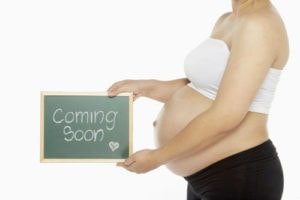
Barnet er nu fuldbårent, og klar til at blive født. De fleste føder dog lidt tættere på terminen. Baby samler næring til den forestående fødsel. Vægten er ofte lidt under 3 kg.
Barnet forbereder sig nu på selve fødslen ved at suge næring til sig. Det sker ved at barnet trækker fostervæske ned i lungerne og derefter presser det ud – igen og igen. Det sidste vand som barnet har i lungerne vil blive presset ud under selve fødslen.
Jordemoderbesøg
Igen vil det være tid til et jordemoderbesøg. Altså et ganske almindeligt besøg der indebærer:
- Måling af blodtryk
- Urinprøve
- Mål symfyse
- Jordemoderen mærker på maven, og lytter måske til babys hjerterytme
Som ved foregående besøg vil der igen blive snakket om selve fødslen og hvis du/I har eventuelle spørgsmål hertil.

5 % af alle gravide føder i denne uge. Barnet vejer mere end 3 kg., men fortsætter med at tage 30-40 gram på dagligt. Det er en god ide at have tasken pakket til fødslen. Læs her, hvad du skal have med på hospitalet.
Tegn på fødsel
De sidste uger inden terminen, er det normalt at være ekstra opmærksom på sin krop. Der kan være forskellige tegn, der måske indikerer at fødslen er i gang. Enhver fødsel er forskellig, men der er alligevel nogen tegn, som du kan være opmærksom på.
- Menstrationslignende smerter
- Hyppigere plukkeveer
- Tegnblødning (en mindre blødning op til fødslen)
Kilde: Hvidovre Hospital
Barnet sover for at samle kræfter
Barnet har ikke meget plads at bevæge sig på nu. Det sover for at samle kræfter til fødslen og til at vokse. Kroppen gør sig klar til fødslen, og du kan opleve små pletblødninger. Kontakt din jordemoder, hvis du bløder meget. Du skal fortsat mærke liv hver dag!
Jordemoderbesøg
Op til terminen er jordemoderbesøgene hyppigere. Barnet skal på dette tidspunkt vende med hovedet nedad, og gerne sætte sig fast i bækkenet. Nogen børn sætter sig først fast i bækkenet under fødslen. Dette er især noget der sker tit hos andengangsfødende.
Tillykke – du nåede til terminen!
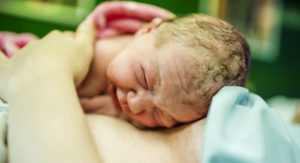
Baby er nu fuldstændig færdigbagt, og du/I bliver snart forælder! Det er en spændende og ny tid, I går i møde. Baby vejer mellem 3-4 kg., og er 50-53 cm. lang. Forbered dig på fødslen ved at lave vejrtrækningsøvelser dagligt.
Snart har du din lille baby i armene.

D-vitamin, folsyre, jern, vitaminpillle…. Der er mange kosttilskud du skal tage som gravid! Se sundhedsstyrelsens anbefalinger.
Gravid uge for uge
Her kan du følge din graviditet uge for uge. Byby udvikler sig og vokser med rivende fart i de 40 uger der går fra befrugtning til fødsel. Det er en spændende rejse, der også kan være hård at komme igennem.
Her har vi skrevet om hvad der sker i hver uge af graviditeten. Oversigten er inddelt efter de tre trimestre.
Hvor langt er du i din graviditet?
Graviditeten er delt op i tre trimestre.
1. trimester (Uge 2 til og med 12)
1. trimester af graviditeten er til og med uge 12. I denne del af graviditeten befrugtes ægget, og fosteret udvikler alle sine vitaler organer. I løbet af de første 12 uger er hjertet fuldt udviklet, halen svinder ind og barnet ligner et rigtigt lille menneske.
I denne del af graviditeten er barnet mest følsomt overfor alkohol, og risiskoen for abort er størst indtil uge 7-8.
Man kan opleve kvalme, luft i maven, kvalme, nedsat sexlyst, humørsvingninger og mange tanker om fremtiden som forældre.
2. trimester (uge 13 til og med 28)
Fra uge 13 – 28 er du i andet trimester af din graviditet. i denne del af graviditeten bliver du tilbudt både nakkefoldsscanning og misdannelsesscanning.
Baby vokser fra at være på størrelse med en blomme og til at være en baby på omkring 1 kg. Maven vokser, og kroppen gør måske ondt. Husk at hvil dig, men sørg også for at holde dig i gang, for eksempel med graviditetssvømning.
3. trimester (uge 39 til og med fødslen)
Fra uge 28 og frem til terminen er den sidste del af graviditeten og kaldes uge 40.
De fleste oplever efterhånden en del gener på grund af graviditeten i form af plukkeveer og bækkensmerter. Det er nødvendigt at sætte tempoet lidt ned, da man hurtigere mister pusten.
I uge 36 begynder barselsorlorven, hvor man kan geare ned og forberede det sidste inden babys ankomst.
Det kan være svært at sove på grund af den store mave, og man kan derfor være rigtig træt og længes mod barnets fødsel.
Hvornår starter graviditeten?
Den første dag i din seneste menstruation inden graviditeten, tæller som “uge 0” i graviditeten. Dagen på din næsten forventede menstruation er derfor uge 4+0 (4 uger og 0 dage). På denne dato vil graviditetstesten for de fleste være positiv. For andre går der lidt længere, før testen viser to streger. Det kommer an på hvornår ægløsning og befrugtning fandt sted.
Hvor mange uger er man gravid?
Terminsdatoen ligger på uge 40+0. Det vil sige, at man er gravid i 40 uger. Babyer der er født fra uge 37+0 og frem til 42+0 anses dog som fuldbåren. Det er derfor en god idé at være klar til baby allerede fra uge 37.
Hvilken uge er jeg gravid i?
Det spørger mange kommende mødre sig nok om, særligt i starten af graviditeten. Du kan regne ud hvor langt du er i graviditeten ud fra den første dag i din seneste menstruation. Herfra tælles ugerne frem til i dag.
Når du fx. går ind i uge 13, hedder det 13+0. Dagen efter er du 13+1, og så er du i den 14. uge frem til 14+0, hvor uge 15 starter.
Kilder:
- Babyinstituttet
- Libero
- Sundhed.dk
- Personlige erfaringer

